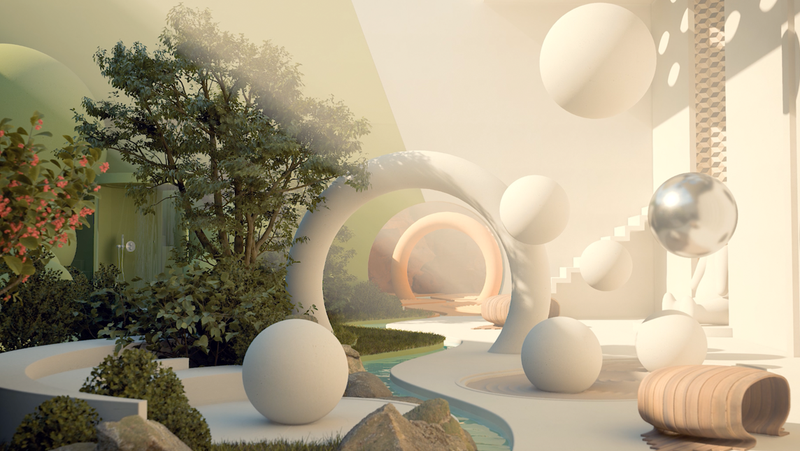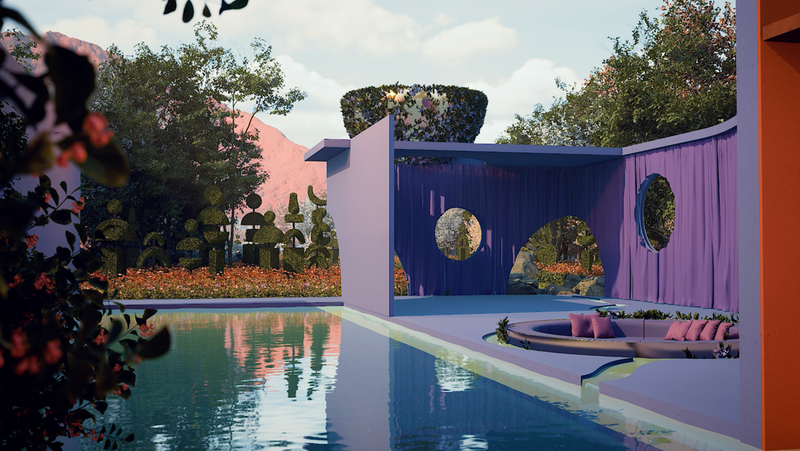‘Let’s persuade educators to take some risks’
Experience Georgia Tucker’s immersive digital installation Lente at Digifest, exploring the benefits of mindfulness and reconnecting with every element of nature.
We spoke to artist Georgia Tucker, whose installation ‘Lente’ will be in Hall 3 at Digifest. She designs and builds large-scale immersive projects, interactive experiences, sculptural works and 3D digital worlds. She has produced work for the BBC, Commonwealth Games, the Royal Horticultural Society, and the United Nations. She also lectures at the University of Birmingham, Aston University and Birmingham City University.
How do you describe your work?
I'm a multidisciplinary artist and designer, and I create sensory and immersive spaces which communicate issues such as climate change and the healing power of nature.
Most of the worlds I build, and the artwork in them, are digital but the installations are physical spaces that people can enter and experience – anything from 10 or 20 at a time to up to 100. It’s a shared experience, which adds to its power.
What was your route to becoming an artist?
I studied fine art at the University of Birmingham School of Art, which was very theory based; they only saw painting, sculpture, drawing as ‘art’. But in my final year I wanted to build a physical installation that filled a whole room. Luckily, I had one forward-thinking tutor who suggested creating it digitally and showing it via a headset – but I still built a tiny little room for the viewer to stand in so they could switch off from the other art and enter my space.
I signed up for a master’s degree to explore physical and digital space further and while studying I was commissioned by the BBC to create an experience about ocean pollution. That was three years ago and I’ve had commissions ever since.

What is Lente?
Lente is my version of a digital zen garden that incorporates all the elements that inspire me, from meditation and yoga to sound bathing and nature. I work with Experience Studios, who help me turn these ideas into big digital immersive environments with spatial sound.
To have it in a physical space, Mailbox Birmingham, the big shopping centre, agreed to let me use an empty retail unit. The response was amazing – it’s the first artwork that I've ever made where people would come back every day just to sit in the space.
At Digifest, what would you like people to take away from the experience?
I’d like to open their eyes to the benefits of these kinds of spaces and how they can inspire students – how meditation, listening to sound and absorbing visuals is really impactful.
Sensory rooms have been used for years, especially with neurodivergent students and children. Many of my peers at university had severe mental health issues at some point during their studies and we need to open up educators’ minds to all the different facets of education, to the creativity and the calming side to education. It doesn't all have to be about learning. There also needs to be some nurture – and nature.
What will Lente’s presence at Digifest, in a space full of people who are in education, bring to your work?
I hope Lente will start a conversation with educators about how they see spaces. When I was at university, a lot of group tutorials took place in very bleak lecture rooms in which we’d sit around tables and try to discuss each other's creative work or ideas. Why does it need to be like that? Why can’t the spaces themselves be more fun and interactive – and creative? But I don't want to tell them what they should be gaining from the space. I’d like to hear what they make of it and how they think it could help them. Some will inevitably think it’s a waste of funding but others might want to start a conversation.
We could all do with more creativity, more thinking outside the box, and educators need to start thinking differently about how education works for different people. We need to persuade educators to take more risks.

What can the immersive experience offer the classroom, in particular?
People often don't realise how important their environment is for them. Especially when you're learning, changing an environment and the whole feel of a space – which you can do through digital worlds and immersive experiences – can completely change how your brain responds. We all have different modes – I'm learning now, now I'm relaxing, now we're playing, now we're doing this – but universities and colleges tend to fail in differentiating between the different modes in their physical spaces.
In terms of learning and teaching, just imagine how much easier it might be to understand a topic in, say, history or geography – or even accountancy – if you were immersed in a space and you could see it and hear it and feel it.
How can these kind of immersive environments, focusing on the natural environment, help to draw attention to the climate emergency?
There’s a truth to ‘seeing is believing’. With the ocean pollution piece I did for the BBC, most of the feedback was, “oh, I didn't realise it was that bad”. But you can't ignore it once you've seen it. With climate change, it is important to give people a calm moment in the day to think about it when they probably wouldn't otherwise. And, in the case of immersive art, to interact with the issue in a specially designed space with the opportunity to start a conversation.
People want to feel they're part of something and, whereas data and the news can increase feelings of disconnection, witnessing something first hand, immersively, can be a very powerful, connecting experience.
Imagination
Georgina develops her immersive digital installation thanks to a spark of imagination.
Find out more
‘Lente’ will be in Hall 3 at Digifest during the day one break.